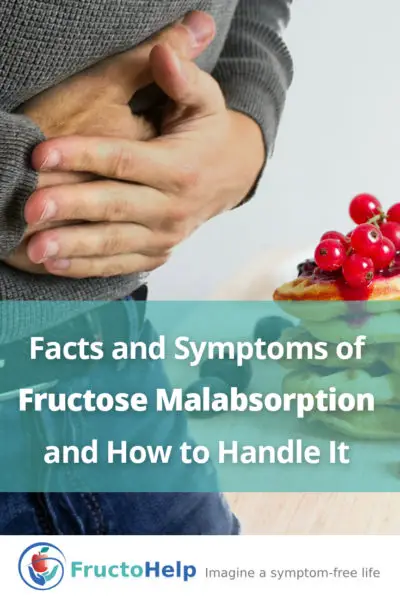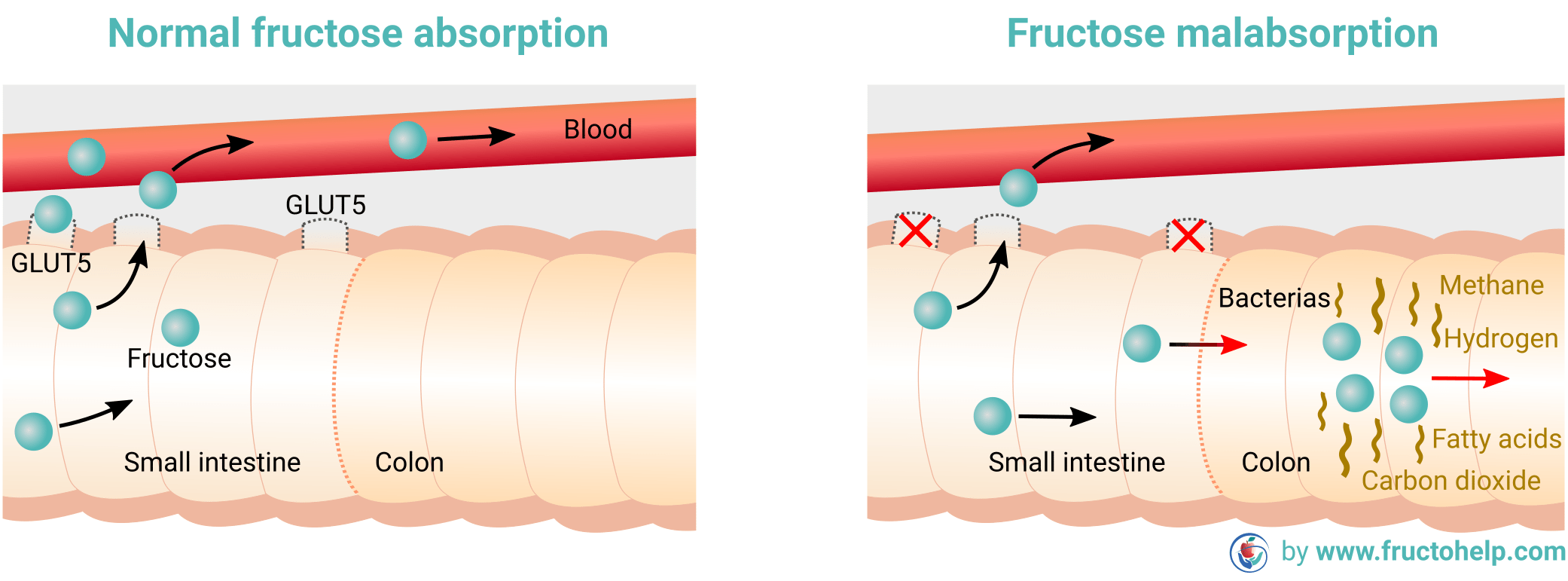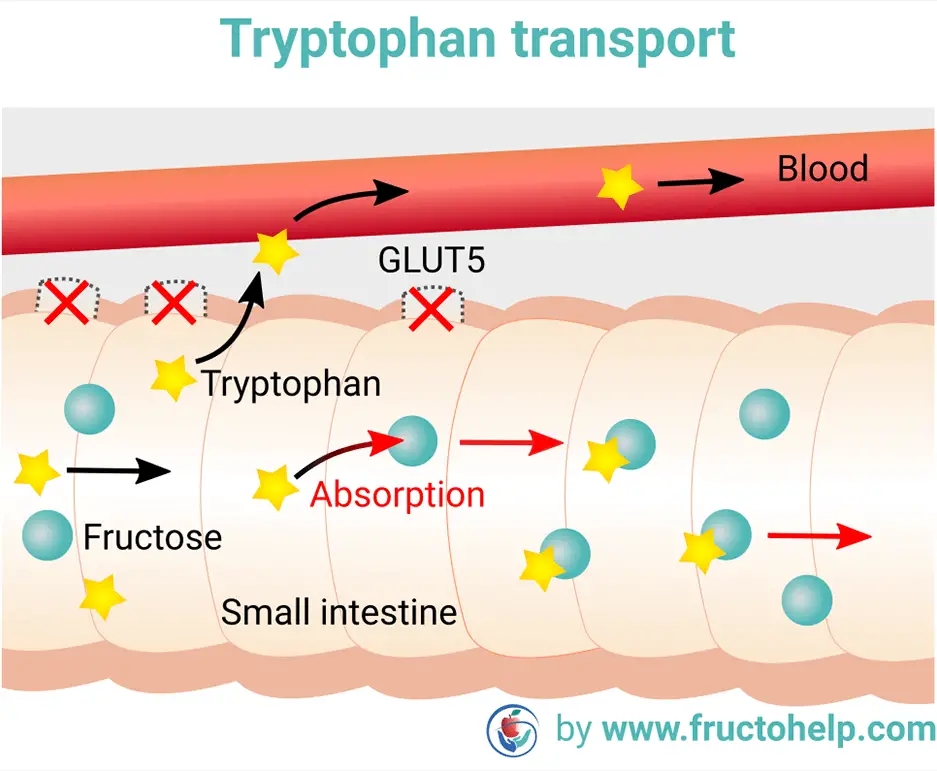What is fructose malabsorption?
Fructose malabsorption (FM), also called dietary fructose intolerance (DFI), is a digestive disorder in which the absorption of fructose in the small intestine is impaired. This leads to several abdominal symptoms like bloating, pain, and cramps. For a long time, the public didn’t know of that disease and physicians often overlooked it. Today we know, that almost 30% are suffering from some kind of fructose malabsorption. 30% of these people show the typical symptoms.
Fructose malabsorption is often called “fructose intolerance”, which is misleading, as there is also a disease called hereditary fructose intolerance (HFI). More about that later. Also, it is no fructose allergy, as some people may guess.
But, let’s dive in!
Skip to a section:
- What is fructose?
- What is wrong in the case of fructose malabsorption?
- What are the symptoms of fructose malabsorption?
- The difference to hereditary fructose intolerance (HFI)
- How do you test for fructose malabsorption?
- How to treat fructose malabsorption?
- Can fructose malabsorption be cured?
- What causes fructose malabsorption?

What is fructose?
Now, some facts about fructose, what it is and how the human body (usually) absorbs it.
Fructose is a naturally occurring sugar, a so-called monosaccharide or a single sugar. It belongs to the poorly absorbable short-chain carbohydrates, also known as FODMAPs (Fermentable Oligosaccharides, Disaccharides, Monosaccharides, and Polyols). Lactose, fructans, sorbitol, and mannitol are further examples of FODMAPs.
You can find fructose in most fruits, honey, some vegetables and in table sugar (sucrose). As it is sweeter than glucose, it is unfortunately used in many processed foods and beverages, although it is no essential nutrient for a human.
There are two ways of absorbing fructose:
- The first way is slow but specific for fructose. Fructose is normally absorbed along the entire small intestine with the aid of a specific protein called GLUT5.
- The second is fast but occurs only together with glucose, which acts as a “piggyback” transport. A rule of thumb states that one molecule of glucose enables the absorption of one molecule of fructose.
This means, that fructose in excess of glucose is potentially malabsorbed if the GLUT5 fructose transporter is not efficient enough or the transit of fructose along the small bowel is too fast.
What is wrong in the case of fructose malabsorption?
In the case of fructose malabsorption, the GLUT5 transporter is impaired, such that fructose is absorbed along the small bowel only to a limited extent. The remaining fructose reaches the colon and gets rapidly fermented by intestinal bacteria, as shown in the figure.

Bacterial fermentation finally results in the formation of hydrogen, carbon dioxide, methane and short-chain fatty acids (e.g. butyric and acetic). I guess you already know, what kind of symptoms these products probably cause. But more about that in a moment.
Furthermore, untreated fructose malabsorption leads to a proliferation of intestinal bacteria and yeast, which metabolize the fructose. This worsens the symptoms over time.
The amount of tolerated fructose varies greatly among fructose malabsorbers. Some people may be able to ingest small amounts of fructose without experiencing any problems, while others show symptoms even after tiny amounts.
What are the symptoms of fructose malabsorption?
When people with fructose malabsorption ingest too much fructose or ingest it in the wrong way they mostly suffer from
- bloating,
- cramps,
- stomach ache,
- diarrhea,
- nausea,
- heartburn,
- metabolic disturbances, including hypoglycemia,
and sometimes
- vomiting,
- fatigue and
- dizziness.

The main symptoms may be similar to the often diagnosed irritable bowel syndrome (IBS). But please notice, that IBS only stands for the occurrence of multiple symptoms, including abdominal pain and changes in the bowel movements, and not for a specific disease.
In the long-term symptoms like
- sugar craving,
- puffy eyes,
- poor absorption of vitamins and minerals, which may lead to anemia, malnourishment, and general poor health,
- poor hair, skin, and nails,
- underweight or difficulty to gain weight,
- various ways of inflammation, including skin problems like eczema, and
- being moody
In several studies, early signs of mental depression and low serum levels of tryptophan walk along with fructose malabsorption. Unabsorbed fructose bonds with tryptophan and makes it unabsorbable, as you can see in the following figure.

Low levels of the amino acid tryptophan can lead to a depressed mood or irritability, as it is essentially required to produce serotonin, which is a hormone that improves and regulates our mood [1-3].
The good news is if you are feeling depressed and fructose malabsorption is really the only cause, a low fructose diet will likely remove your depressive states.
The difference to hereditary fructose intolerance (HFI)
Besides fructose malabsorption, which can occur suddenly and as a result of external influences, there is also another fructose-related disease. It is called hereditary fructose intolerance. In contrast to fructose malabsorption, which is based on an impaired GLUT5 fructose transporter, hereditary fructose intolerance is an extremely rare life-threatening disorder of the fructose metabolism within the human body. HFI is usually diagnosed in early childhood.
A genetic defect causes a deficiency in the fructose-1-phosphate aldolase B activity. This deficiency leads to an accumulation of fructose-1-phosphate, a derivative of fructose, within the liver. And this, in turn, causes severe toxic symptoms after fructose ingestion, such as serious hypoglycemia with tremors, vomiting, and disorientation. In the worst case, it can lead to convulsion and coma.
You see, symptoms of fructose intolerance differ significantly from ours. We can even be happy, having fructose malabsorption and not HFI, as there are several effective ways to handle our impairment.
How do you test for fructose malabsorption?
The most meaningful test for fructose malabsorption is a professional hydrogen breath test, which looks like follows:
- Your breath gets analyzed for hydrogen gas after fasting for several hours.
- Then, you consume a certain amount of fructose.
- After that, breath samples are taken multiple times within the next three hours.
- If the amount of hydrogen gas rises above a certain threshold, it indicates that your body has trouble absorbing fructose.
If you want to read more about that test or about how you can do some self-checks, head over to my Testing page.
How to treat fructose malabsorption
First, there is some xylose isomerase supplement which acts as a temporary cure for fructose malabsorption. Whenever you take it, you can eat everything you crave for a certain time.
Second, there is a special Fructose Malabsorption Diet, which is a low FODMAP diet with fewer restrictions, for reducing your symptoms and, in some cases, restoring normal gut function. I recommend to read the diet first, and then head over to my Fructose Malabsorption Food List, Tips, and Helpful Resources pages.
Can fructose malabsorption be cured?
Currently, there is no cure for fructose malabsorption. But with a proper diet and enzyme supplementation, as stated before, the gut function can be improved and thus the amount of tolerable fructose. Some people are even able to eat normally after months or years of patience and diligence.
What causes fructose malabsorption?
Fructose malabsorption can have many causes, such as chronic exposure to
- the wrong diet (e.g. high intake of fructose-rich foods),
- environmental pollution and pollutants (e.g. living in a room with extensive mold),
- stress,
- inflammation,
- bacterial abnormalities (e.g. an overgrowth or an imbalance of good and bad bacteria),
- and drugs.
All of these can lead to intestinal damage.
There are also several gut issues and diseases which can lead to fructose malabsorption, such as the celiac disease.
Now that you know the causes, you might figure out which of them may fit your case and what you can change in your environment.
References
- Ledochowski M, Widner B, Bair H, Probst T, Fuchs D. Fructose- and sorbitol-reduced diet improves mood and gastrointestinal disturbances in fructose malabsorbers. Scand J Gastroenterol 2000;35(10):1048-52.
- Ledochowski M, Sperner-Unterweger B, Widner B, Fuchs D. Fructose malabsorption is associated with early signs of mental depression. Eur J Med Res 1998; 3(6):295-8.
- Ledochowski M, Widner B, Murr C, Sperner-Unterweger B, Fuchs D. Fructose malabsorption is associated with decreased plasma tryptophan. Scand J Gastroenterol 2001; 36(4):367-71.
- Ledochowski M, Überall F, Propst T, Fuchs D. Fructose malabsorption is associated with lower plasma folic acid concentrations in middle-aged subjects. Clinical Chemistry 1999; 45(11):2013-14.
- Gibson P R, Newnham E, Barrett J S, Shepherd S J, Muir J G. Review article: fructose malabsorption and the bigger picture. Alimentary Pharmacology & Therapeutics 2007; 25(4): 349-63.
- Ushijima K, Riby J E, Fujisawa T, Kretchmer N. Absorption of fructose by isolated small intestine of rats is via a specific saturable carrier in the absence of glucose and by the disaccharidase-related transport system in the presence of glucose. J Nutr 1995; 125(8):2156-64.
Holy Moly Nick..I’m so glad I happened upon your web page..it is so full of information in one spot. Thank you for all your knowledge…I know I’m finally on the right road of recovery!